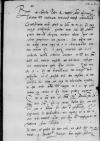Letter #2319
Seweryn BONER to Ioannes DANTISCUSWieliczka, 1540-06-10
| received Heilsberg (Lidzbark Warmiński), 1540-07-06 Manuscript sources:
| ||||
Text & apparatus & commentary Plain text Text & commentary Text & apparatus
Reverendissimo in Christo Patri et Domino, domino
Reverendissime in Christo Pater et Domine, domine observandissime.
Salutem et studiosam servitiorum meorum commendationem.
Gratissimum mihi fuit ex litteris Reverendissimae Dominationis Vestrae, quas nuper accepi, intellexisse gratas meas litteras illi fuisse, grata mea ista obsequia accidere solere, quae sine scelere praeterire non possem. Sane vellem omnibus modis meam erga Reverendissimam Dominationem Vestram observantiam testatam facere illi. Id, postquam serviendo non licet, scribendo saltem ostendere conamur, ne et hoc qualibet vili munere neglecto aut intermisso, negligentiae suspicionem apud illam adirem. Quod vero Reverendissima Dominatio Vestra de sua benevolentia tam benigne mihi pollicetur, est id profecto mihi tam amplum, ut iam beneficii loco istam eius erga me voluntatem reputem. De qua certe multas et magnas Reverendissimae Dominationi Vestrae ago gratias daturus semper operam, ut illa dignus gratusque cognoscar.
Quas Reverendissima Dominatio Vestra mihi ad dominum reverendissimum
In novis est quidem hic nunc nihil, nisi forte illud huc pertineat, quod sacratissimi  BCz, 1597, p. 1052
BCz, 1597, p. 1052
De externis scio Reverendissimam Dominationem Vestram minime omnium, quod usque gentium geratur, ignorare. Quod ipse in hoc genere habeo, volui id cum Reverendissima Dominatione Vestra communicare. Sententiae exemplum est a
Cum iis me meaque obsequia Reverendissimae Dominationi Vestrae offero commendoque diligentissime, quae illi ad demerendam tuendamque eius gratiam hidden by binding⌈[m]m hidden by binding⌉ erunt semper prona. Opto Dominationem Vestram Reverendissimam incolumem et bene fortunatam diu valere.
Datum ex
Reverendissimae Dominationis Vestrae paratissimus servitor


